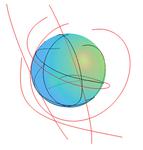Frontiers of Physics ( IF 6.5 ) Pub Date : 2024-04-16 , DOI: 10.1007/s11467-024-1403-x Arthur Vesperini , Ghofrane Bel-Hadj-Aissa , Lorenzo Capra , Roberto Franzosi

|
We show that the manifold of quantum states is endowed with a rich and nontrivial geometric structure. We derive the Fubini–Study metric of the projective Hilbert space of a multi-qubit quantum system, endowing it with a Riemannian metric structure, and investigate its deep link with the entanglement of the states of this space. As a measure, we adopt the entanglement distance E preliminary proposed in Phys. Rev. A 101, 042129 (2020). Our analysis shows that entanglement has a geometric interpretation: E(∣ψ〉) is the minimum value of the sum of the squared distances between ∣ψ〉 and its conjugate states, namely the states νμ · σμ∣ψ〉, where νμ are unit vectors and μ runs on the number of parties. Within the proposed geometric approach, we derive a general method to determine when two states are not the same state up to the action of local unitary operators. Furthermore, we prove that the entanglement distance, along with its convex roof expansion to mixed states, fulfils the three conditions required for an entanglement measure, that is: i) E(∣ψ〉) = 0 iff ∣ψ〉 is fully separable; ii) E is invariant under local unitary transformations; iii) E does not increase under local operation and classical communications. Two different proofs are provided for this latter property. We also show that in the case of two qubits pure states, the entanglement distance for a state ∣ψ〉 coincides with two times the square of the concurrence of this state. We propose a generalization of the entanglement distance to continuous variable systems. Finally, we apply the proposed geometric approach to the study of the entanglement magnitude and the equivalence classes properties, of three families of states linked to the Greenberger–Horne–Zeilinger states, the Briegel Raussendorf states and the W states. As an example of application for the case of a system with continuous variables, we have considered a system of two coupled Glauber coherent states.
中文翻译:

揭示量子纠缠的几何意义:离散和连续变量系统
我们证明了量子态的流形被赋予了丰富且重要的几何结构。我们推导了多量子位量子系统的射影希尔伯特空间的富比尼-研究度量,赋予它黎曼度量结构,并研究了它与该空间状态纠缠的深层联系。作为衡量标准,我们采用Phys.1中初步提出的纠缠距离E。修订版 A 101, 042129 (2020)。我们的分析表明,纠缠具有几何解释:E (∣ ψ 〉) 是 ∣ ψ〉 与其共轭态(即状态ν μ · σ μ ∣ ψ 〉之间的距离平方和的最小值,其中ν μ是单位向量,μ在参与方数量上运行。在所提出的几何方法中,我们推导了一种通用方法来确定两个状态在局部酉算子的作用下何时不是同一状态。此外,我们证明纠缠距离及其向混合态的凸顶扩展满足纠缠度量所需的三个条件,即: i) E (∣ ψ〉) = 0 iff ∣ ψ〉 是完全可分离的; ii) E在局部酉变换下保持不变; iii) E在本地操作和传统通信下不增加。为后一个属性提供了两个不同的证明。我们还表明,在两个量子位纯态的情况下,状态∣ψ>的纠缠距离等于该状态并发度的平方的两倍。我们提出将纠缠距离推广到连续变量系统。最后,我们应用所提出的几何方法来研究与 Greenberger-Horne-Zeilinger 态、Briegel Raussendorf 态和 W 态相关的三个态族的纠缠大小和等价类属性。作为连续变量系统的应用示例,我们考虑了两个耦合的格劳伯相干态的系统。











































 京公网安备 11010802027423号
京公网安备 11010802027423号